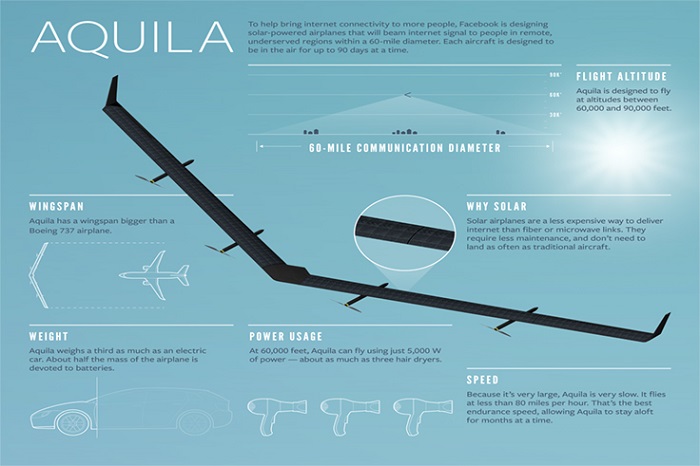While the idea of beaming internet from satellites via Aquila to people below might come off as an expensive crackpot scheme, perhaps there’s some merit to the project. Looking at distribution of internet across the globe shades light on the genius of Facebook founder, Mark Zuckerberg’s dauntless project to get to those areas without. On that point, we don’t have far to look. The African continent is home to approximately 1 billion people. Of that number a little more than 300 million have access to the internet, presenting a 28% penetration rate. In that regard, the accessible Internet is expensive and is often a slow, choppy connection. In contrast, Asia has a penetration rate of 44% of an even bigger population of 4 billion. The rest of the world exceeds 50% penetration showing a stark divergence in Internet accessibility between the developed and underdeveloped world.
Facts about Facebook’s Aquila Project
Each plane flies at 60,000 feet above a village/city beaming internet for months at a time. Solar panels on the wings charge the plane’s batteries during the day and discharged at night to keep the drone in flight The energy requirement of each plane is 5,000 watts, roughly the power of 3 blowdryers. New aircraft will be deployed to replace those due for maintenance and repairs. The planes have pads rather than wheels due to their slow speed (23-30mph) hence can smoothly glide back to the ground.
Facebook’s Internet versus Satellite/Telcos
At a height of 60,000 feet, the aircraft fly above the weather, so hypothetically, they should continue providing an internet connection below, rain or shine. Additionally, the aircraft can communicate with each other using lasers. If service is interrupted, other planes will re-route internet to keep users below connected Think about it this way. It’s not economically sustainable to build a fast cell phone tower just to serve one family in a rural area. The cost of building that tower is more than the value it would create. But it is economically sustainable to build a plane that could serve many families in different areas all at once. So the most efficient way to serve people in cities may be cell phone towers on the ground, whereas the most efficient way to serve people in more rural areas may be planes. Different population densities need different technologies. Government and industry support in each country will be very important. We’ll get some experience with this when we launch our first satellite over sub-Saharan African later this year. The good news is that we’re going to offer our technology to telcos and governments to extend their existing networks, so they should want to work with us rather than blocking us out of their countries. Compared to satellites, drones cost much less financially to put in the sky, therefore justifying their usage. Furthermore, the cost of scaling ground infrastructure by telcos is astronomical if they are to reach every pocket of habitation. At times the cost versus reward is against them thus choosing to leave some areas without an internet connection. On the other hand, satellites and telcos can provide much faster speeds with the right infrastructure compared to Aquila drones. Where Aquila beams down bandwidths of 10s of GBs at a time, satellites can do 100s of GBs, so it does have its pros and cons.
Watch a clip of what it took to take Aquila to the sky
Cost-effectiveness
Featured Image: Getty Images

